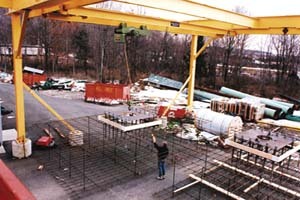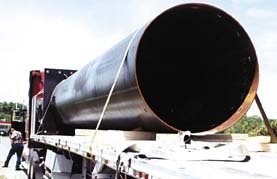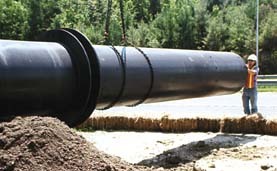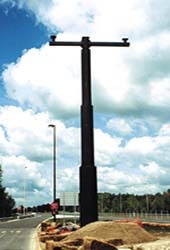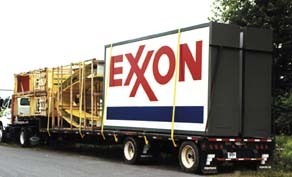Digital Printing
Super-sized Signage
First, the good news: MassPike’s new signs are getting noticed. Now, the bad news: Same thing.
Published
18 years agoon
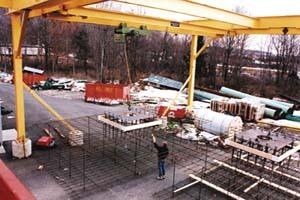
What’s 123 miles long, 44 years old and used by 94.4 million people a year? It’s the Massachusetts Turnpike, or, as it’s more commonly called, the "MassPike." For a cost of only $3.60, you can travel the entire length of Interstate 90 — from the state’s New York border to its capital, Boston.
Because the Massachusetts Turnpike Authority receives no federal or state tax dollars for the MassPike’s upkeep, expenses are paid not only by tolls, but also through leasing, advertising and the development of real-estate and air rights. Among its revenue sources, the Turnpike Authority leases space along the highway for restaurants and gas stations to set up "travel plazas."
Located no more than 38 miles apart from one another, these travel plazas are a great convenience, as they may be accessed directly from the pike. Thus, they eliminate the need for drivers to exit the turnpike, eat or refuel, and then pay a toll to re-enter the highway.
Originally, Howard Johnson’s restaurants leased the 11 plazas along the pike. Over time, however, Hojo’s gave way to Burger Kings and Mobil gas stations. As part of a recent $24 million travel-plaza makeover, BK and Mobil have now been replaced mainly by McDonald’s and Exxon stations, but also by a few Papa Gino’s, D’Angelo’s and Boston Market restaurants.
McDonald’s and Tosco (Exxon’s parent company) have reportedly paid dearly to access the highway’s "captive" consumers. The companies’ 20-year contract is a fiscal windfall for the Turnpike Authority, which is guaranteed $13.7 million in revenue the first year alone — more than double the average annual take of $6.5 million under the old concession contracts.
In addition to paying for tenant privileges, the companies have invested in new buildings for their franchises. Plus, they’ve paid for each plaza to have a new, freestanding pole sign.
AdvertisementDesign
In October 2000, McDonald’s contacted Plasti-Line Inc., a Knoxville, TN-based sign company that manufactures much of "Mickey D’s" signage, about the MassPike’s new signs. Representatives from both companies, including Plasti-Line’s Senior Field Activities Manager Freeman Smith, met with Turnpike Engineer David Comerford, other turnpike officials and representatives from Tosco, Cellular One, AT&T and Sprint to discuss project details.
Also on hand were personnel from Saxton Sign Corp. (Boston; Hartford, CT; Albany, NY) — the sign company that has converted many BP stations to Exxons and that’s long been a sign installer for Plasti-Line.
Prior to that meeting, Plasti-Line created initial designs for the proposed signage. During the discussion, however, the sign company learned about engineering changes required for the signs’ poles.
Specifically, the inside of the columns would need to accommodate 24-in.-diameter PVC conduit, through which cell-phone cables could be fed. In addition, the upper section of each pole would need to include "hand holds" and a "stub" between the sign faces, on which to mount a cellular tower. Most significantly, each pole would need to be strengthened to meet Association of State Highway and Transportation Officials (ASHTO) specifications — standards typically used on such structures as bridges.
To meet this third requirement, each column needed to be completely re-engineered. For example, Plasti-Line’s design for an 85-ft.-tall sign pole originally specified three tiers whose diameters measured 48, 42 and 40 in. When redesigned to meet ASHTO specs, the tiers’ diameters would have to change to 72, 54 and 42 in., respectively.
AdvertisementIronically, such changes were required even though 52-year-old Plasti-Line has frequently used 48-in.-diameter poles at oceanfront locations, where windload is an especially critical issue.
"We’ve not had any problems in the past," Smith says. "In fact, we’ve had some columns up for 35 years."
Determining the necessary height of each travel-plaza sign required performing "flag tests." During the tests, representatives from the Turnpike Authority, McDonald’s, Tosco and Saxton evaluated each travel plaza to determine the best sign placement for maximum conspicuity.
To perform the flag tests, they traveled to each of the sites with a crane. The crane lifted a 4 x 8-ft. sheet of red-painted MDO to various heights. Then, representatives from each company — with walky talkies in hand — drove away from the crane to see how far away the MDO could be viewed. Their testing proved the sign poles would need to vary in height from 60 to 90 ft., depending on the site. (For comparison, Burger King’s previous signs measured between 60 and 70 ft. tall.)
"The height of the signs was everybody’s decision," explains Mike Kellogg, Saxton’s vice president. "We flag-tested every location, and the sign heights were determined based on geography and trees in the area. Our whole concern was how to advise drivers — who are supposed be traveling 65 mph, but who really travel 75 mph — that they need to make a lane change to enter the plaza. [As a result of our diligent testing,] some of the signs can be seen up to three miles away."
Fabrication
AdvertisementWith column widths and heights determined — and multiple sets of drawings and approvals in the books — fabrication commenced.
For all its MassPike sign faces, McDonald’s opted to use model 90-200, the franchisor’s largest, standard-size, rigid-plastic sign face. Manufactured by Plasti-Line, the model 90-200 sign measures 270 sq. ft. "boxed in" — that is, if you count the space between the arches into the square footage. It measures 125 sq. ft. if you count only the sign face itself. The next largest standard McDonald’s sign face measures only 137 sq. ft., boxed in.
So that the gas stations’ faces would "visually balance" the McDonald’s faces, Saxton manufactured Exxon’s cabinets to a size of 10 x 20 ft. Saxton also produced some "dual-concept" sign faces. These looked like the Exxon signs, but they were split to house D’Angelos, Papa Gino’s and Boston Market’s logos.
Seventy-two- and 54-in.-diameter poles aren’t standard, so Saginaw Steel Co. (Saginaw, MI) special-rolled the 30,000-lb. columns. They then primed and rust-proofed the poles’ interiors, and primed and painted their exteriors.
McDonald’s thus paid $20,000-$30,000 more for each pole than if standard-sized poles had been used, reports Smith. That amounts to roughly a quarter million dollars of additional expense for pole manufacture alone — and doesn’t even include extra costs for concrete and installation.
Installation
Saxton’s crews handled all excavation and installation, which commenced in April 2001. The poles’ large size meant that only one column and cross-member could be transported per flatbed truck.
With Saxton’s 30-ton crane, back hoes, concrete trucks and tractor trailers working so closely to the highway, police officers closed down some exit ramps and monitored the speeding traffic nearby.
"Traffic control was a challenge because cars were moving 70 mph 3 ft. away from where we were working," Kellogg says.
Saxton put up the signs in stages, rather than installing one sign in its entirety and then moving onto the next. Crew members first dug the foundations for all the sites. Then, they performed steel work at all the sites, installed all poles, painted all poles to touch up scratches incurred during transport, performed all wiring and last, but not least, installed all faces.
Each footing required an approximately 17 x 32 x 6-ft. hole, a rebar cage made from 6,000 lbs. of steel, 125 yds. of 5,000-psi state-approved concrete (approximately 85 yds. of 3,000-psi concrete could have been used with a smaller pole) and a 6 ft., 6-in. pedestal, to which a mounting plate was attached with 12, 21/2 x 60-in., galvanized, anchor bolts.
Interestingly, after the sign faces were up, the Turnpike Authority asked that two be removed until the construction of the McDonald’s buildings at those sites was completed. As such, McDonald’s not only footed the bill for those faces’ initial installation, but also their removal and re-installation.
Reflecting on the job, Kellogg says the project was unusual simply because of its technical scope: "Everything was overdesigned. We used so many yards of concrete."
Legislative concerns
Since their installation, the signs have garnered much negative press. Some communities near the turnpike are upset that the Turnpike Authority issued the requisite sign permits even though the structures’ sizes exceed limits set by the towns’ local sign codes.
In the August 8, 2001 Telegram & Gazette, Lee Lyman, president of Lycott Environmental Inc. of Southbridge, MA, said the signs "are not compatible with the aesthetics of the turnpike or the New England heritage." This is not Lyman’s first complaint about signage, however; in the past, he has reportedly lodged public complaints about Boston Bruins’ advertising in the Boston Garden.
In the August 15, 2001 Berkshire Eagle, Berkshire County State Representative Christopher J. Hodgkins, D – Lee, called the signs an eyesore and out of scope with the New England landscape. "They are totally inconsistent with the decisions of what’s going on in the area," Hodgkins was quoted as saying. "Why should people on George St. in Lee have to be staring at McDonald’s signs at 11 at night? They’re obtrusive and don’t make sense."
And the October 14, 2001 Berkshire Eagle reported that State Senator Andrea F. Nuciforo Jr., D – Pittsfield, in conjunction with 17 other state lawmakers, is sponsoring a bill to cap the height of all vendor signs on the turnpike to 30 ft. This bill would also require McDonald’s and Tosco to remove their current signage. The article cited no reason for why the lawmakers determined that 30 ft. was the appropriate height for highway signage.
Still, not everyone loathes the signs. Hazel Hopkins (Boston), a permit broker who helps architects, designers and signmakers secure permits, says, "The towns are just annoyed that there’s a sign in their space. Could you imagine if each town could regulate signs on the pike? We’d have signs lit by candles."
"The signs themselves are not so big; the columns are what’s big," Smith says, adding that his inlaws and their friends, who took a bus tour through Massachusetts last summer, actually complimented the signs. "They stopped at a travel plaza where one of the signs was located. And the people on the bus were commenting it was nice to be able to see the sign so they could stop and get something to eat."
SPONSORED VIDEO
Introducing the Sign Industry Podcast
The Sign Industry Podcast is a platform for every sign person out there — from the old-timers who bent neon and hand-lettered boats to those venturing into new technologies — we want to get their stories out for everyone to hear. Come join us and listen to stories, learn tricks or techniques, and get insights of what’s to come. We are the world’s second oldest profession. The folks who started the world’s oldest profession needed a sign.
You may like
Advertisement
Subscribe

Magazine
Get the most important news
and business ideas from Signsofthetimes Magazine.
Advertisement
Most Popular
-

 Tip Sheet4 days ago
Tip Sheet4 days agoAlways Brand Yourself and Wear Fewer Hats — Two of April’s Sign Tips
-

 Business Management2 weeks ago
Business Management2 weeks agoWhen Should Sign Companies Hire Salespeople or Fire Customers?
-

 Women in Signs2 weeks ago
Women in Signs2 weeks ago2024 Women in Signs Award Winners Excel in Diverse Roles
-

 Real Deal5 days ago
Real Deal5 days agoA Woman Sign Company Owner Confronts a Sexist Wholesaler
-

 Benchmarks1 day ago
Benchmarks1 day ago6 Sports Venue Signs Deserving a Standing Ovation
-

 Editor's Note1 week ago
Editor's Note1 week agoWhy We Still Need the Women in Signs Award
-

 Line Time2 weeks ago
Line Time2 weeks agoOne Less Thing to Do for Sign Customers
-

 Product Buying + Technology1 week ago
Product Buying + Technology1 week agoADA Signs and More Uses for Engraving Machines

